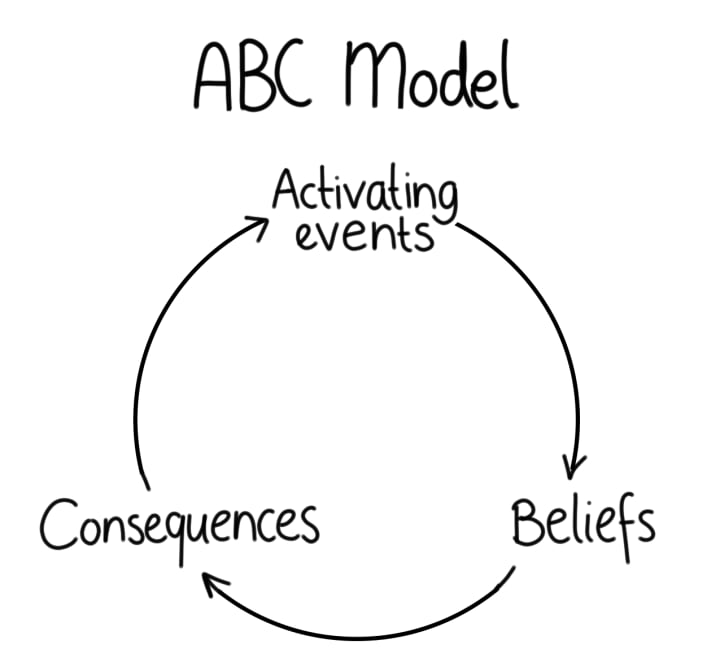Pitfalls of Your Mind
How Changing Your Thoughts Can Change Your Life

Throughout the day, we evaluate our experiences within the narratives our own mind creates. We respond and react to the events we encounter, often in the form of “This happened, hence I think/feel/act as such.” It is perhaps easier to pinpoint how our actions lead to certain consequences, but what we often miss is how our thoughts shape our experiences in the first place.
For instance, say you run into a friend on the street. You wave at them, yet they walk by hastily without acknowledging your greeting, and you are left there wondering what might have happened. What are your first thoughts in such an incident? Is it “That was rude! I just tried to say hi and he just ignored me. I must have done something to upset him”, or is it “He looked very preoccupied, hope everything’s alright with him”? From this very simple example, we can see how these different train of thoughts, stemming from identical pieces of information will determine your reaction and subsequent feeling about the incident.
ABC Model

The model is usually depicted linearly, however I believe the consequences you face in life also influence future triggering events so I see a cycle as fitting in this case.
This is the main premise of the ABC model formulated by Dr.Albert Ellis, a world-renowned psychologist, where "A" stands for "activating events," "B" stands for our "beliefs" about the event, and "C" stands for the consequences we encounter as a result. What this suggests is that—despite the common misconception—our experiences are shaped not only by the external events that happen to us, but are filtered through the beliefs we hold about ourselves, others and the world. So, we are not simply idly passing through our lives as recipients of events, but we indeed have agency over the lens we see the world through.
Ellis’ theory combined with the works of Dr.Aaron Beck, who is one of the most influential psychologists in today’s world, have led to the development of Cognitive Behavioral Therapy (CBT), a problem/solution-focused therapy aimed at breaking the vicious cycles our faulty thought patterns put us in, and in doing so, improving our mood, feelings and our overall quality of life.
The Ten Forms of Twisted Thinking
- All-or-nothing thinking—also called “black-and-white thinking”, refers to a perfectionist style of evaluation, where even a small mishap can “ruin” a situation entirely. An example would be a straight-A student who receives a subpar grade in one assignment and thinks to themselves: “I have completely ruined my GPA!" possibly leading to decreased motivation for the rest of the year.
- Overgeneralization—if you see yourself constantly using phrases such as “always” and “never," you might very well be a victim of your own mind in overgeneralization. In this sort of thinking, an exceptional event would be taken as representing the entirety of the situation. An example is a woman thinking to herself, after her husband keeps her waiting for dinner one night: “He is always late! We never get things done in time!”
- Mental filter—this refers to the act of letting a single negative event affect your entire perception of reality. Dr. Burns portrays this as “the drop of ink that discolors a beaker of water." An example would be despite getting positive feedback from most of your friends about your new haircut, dwelling on the one person saying: “I liked your old hair better” and ruminating on the thought that you “ruined your hair” and letting this ruin your day as a result.
- Discounting the positive—constantly devaluing positive events by saying “they don’t count” or “anyone could have done it."
- Jumping to conclusions—two common types are mind-reading (placing negative attributions to someone’s reaction towards you with no solid ground to do so), and fortune-telling (concluding that events will turn out bad regardless of how much basis this has on reality).
- Magnification—also called the “binocular trick," where you exaggerate your problems so much that they entirely diminish the positive aspects of yourself or your life in your eyes.
- Emotional reasoning—mistakenly attributing the strength of your present emotions to the reality of the situation. For example; “If I feel this bad about it, then the situation, must indeed, be that bad!”
- “Should statements”—referred to as “musturbation” by Dr. Albert Ellis, evaluating your actions in terms of how you “should” and “shouldn’t” be. This penalizing attitude almost guarantees agitation and often leads people to act in an entirely opposite way to their initial expectation. An example would be “I shouldn’t have went out with friends last night when I have an assignment due in two weeks. I should be studying for the entire day”.
- Labeling—described as an extreme form of all-or-nothing thinking, this refers to the evaluation of your (or others’) entire being based on a single event. For instance, when your partner makes a comment about your outfit that you deem extremely rude, you label them by calling them a “jerk” or “insensitive," attributing their one action to their personality.
- Personalization and blame—this can occur in two ways; either you take the blame for something that you may not fully have control over and feel guilty as a result (e.g. upon breaking up with your partner thinking: “I ruined the whole relationship, it’s all my fault!”) or doing the exact opposite by placing blame on others while discounting your possible contribution to a situation (e.g. “We broke up because he is an awful person and treated me terribly, he ruined the whole relationship!”).
Where to go from here:
Dr. Burns notes that this list does not mean that every single negative thought or emotion is unhealthy. There are situations where it is completely natural and fitting to experience negativity, so the aim is not to eliminate them altogether, but to be able to differentiate when you are holding onto certain thoughts and beliefs that do not serve you well in a given situation.
That being said, this requires a great deal of practice as most of these thoughts are automatic, hence often insidious. You can start by familiarizing yourself with the items on the list, and trying to come up with examples of when you might have recently engaged in such thoughts. A retrospective approach is often useful, where you go through your day noting down triggering events and your subsequent thoughts (with no need of filtering them), and referring back to them later to see which item on the list they might fit into.
Soon enough, you will start to realize when these are happening, and might even correct your patterns of thought on the spot. This will end up making you feel empowered, and rather than being seemingly drifting away in your emotions, you will be able to take charge in building a happier, more fulfilling life for yourself.
References
Burns, D. D., , MD. (1999). The Feeling Good Handbook. New York, NY, USA: Plume Book.
McLeod, S. (1970, January 01). Cognitive Behavioral Therapy. Retrieved from Simple Psychology
About the Creator
Gulce Sakallioglu
Master's student in mental health and newbie yoga teacher, writing about all things 'well-being'.






Comments
There are no comments for this story
Be the first to respond and start the conversation.